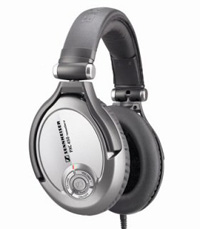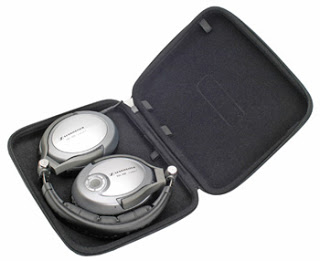As a music composer, producer and sound engineer, I need a good pair of headphones. I’ve been using a pair of Sennheiser headphones for years that I was always quite pleased with, but with the number of computers, fans, servers, external hard disks and even hard disks in hardware outboard samplers around me, frankly, the noise level in my working environment was beginning to get untenable.
I saw a pair of Bose noise canceling headphones at an airport, and it occurred to me that most people who buy this type of headphones do so because they want something to use while on flights. Frankly, I don’t fly that often that I feel the need to pay hundreds of dollars for a pair of headphones used especially for in-flight use, but I do spend hundreds, thousands of hours working on music and sound effects in an environment filled with noisy computers and hard disks, so I found I wanted to invest in a pair for use in my office/studio – not primarily for flights.
I spent some time getting to know a few different models, and in the end I decided to go with these Sennheiser PXC 450 Noise Guard Noise Canceling Headphones. They were among the more expensive noise reducing headphones on the market, but since I was going to use these for hundreds and hundreds of hours, I wanted to invest in something of very good quality and not simply get the cheapest.
Background on noise canceling technologies
For those who don’t quite know what this “noise canceling” stuff is all about, there are basically two types of noise reduction used in headphones: Passive noise reduction and Active noise reduction.
Passive noise reduction simply means the physical blocking out of external noise. Headphones can be made to fit so snugly around your ears and the ear muffs can be made with a material that blocks out noise.
Active noise reduction / noise canceling, on the other hand, is a lot more complex. It involves tiny microphones on the outside of the ear muffs that actually keep a digital footprint of the sound waves that can be heard on the outside, and then uses clever technology generate an “opposite” noise footprint which is then broadcast/played inside the earmuffs, to “counter-act” the noise. Depending on how well this technology is implemented, it can be quite baffling and very impressive. This technology is also used inside some cars, to cancel out the noise of traffic from the outside.
First impressions
The Sennheiser PXC 450 headphones feel very exclusive, expensive and classy 2 I mean that both in the sense of holding them and handling them, and how they feel when you’re wearing them. The padding around your ears is very comfortable and overall it feels really nice to wear them. They fit softly and comfortably. You can wear these for hours without feeling any discomfort. Great work by Sennheiser here.
Having said that, the first time I put these on, I was surprised and a little discomforted by hearing a low “hum”, like a fan running at 50 Hz or so inside. I felt it was really quite loud as well. I adjusted the position of the headphones a little bit on my head, and the hum disappeared. I’m not sure what that’s all about or what’s causing it, but occasionally when I put them on, I have to adjust them a little bit by slightly changing the angle at which I’m wearing them on my head, to get rid of that nasty low humming sound.
Sound quality
As a pair of headphones, the PXC450 sound really good. Listening to music, the music sounds very crisp, warm, transparent and clear. Quite simply, they sound like pure class. The bass is nicely defined and sits perfectly in the mix. The mid-tones and treble are tremendously clear and at the same time, relaxed, natural and clean. All in all, it’s a tremendous pleasure to listen to well recorded and well produced music in these headphones.
The noise canceling
Let’s talk about the actual noise canceling qualities of these headphones – and I’m afraid this is where my enthusiasm takes a downturn. I read on the distributor’s website that these headphones would block out 80-85% of all outside noise. I’m sorry, but personally I simply find that to be untrue. Sitting in a room with several noisy computers, I can still hear these computers even when wearing these phones. And if somebody in the next room talk, I can hear their voices. In fact, even if somebody downstairs is talking, I can not only hear them, but I can hear what they are saying. And if a car drives up on the outside of the building, I can hear it. That’s not what I was expecting from these rather expensive noise canceling headphones.
In my estimation, I’d say that the true noise reduction percentage from these is about 35-40%, not the promised 80-85%. It’s hard to put a number on it, but if I had to try, I’d say that I probably hear about 35-40% less from the noise around me, when wearing these phones switched on in noise canceling mode.
Other features
Like other noise canceling headphones, the PXC 450 requires a battery. It uses a single AAA battery which lasts for several hours. I like the fact that it doesn’t use its own special battery type which must be charged all the time. Instead it uses a standard battery which means that you have the choice of simply buying regular batteries, or to buy a rechargeable one.
Unlike some other noise canceling headphones, these also work as normal headphones, even without a battery. So if you’re somewhere without access to batteries, at least you’ll still be able to use them as normal headphones, without the noise canceling feature. I feel this is a valuable feature, as some other noise canceling headphones would simply be completely useless without a battery.
Talk-through feature
On the right earmuff there is a “talk through” button. You press it, a little green light comes on, and the little microphones on the outside of the earmuffs actually record the sound and play it back into the headphones. Useful if you’re listening to music and somebody just wants to say something to you, or you want to listen out for something for a couple of seconds – without having to remove the headphones and/or stop the music. You press the talk-through button and listen to the outside world for a couple of seconds, then press the button again to return to your music.
Packing/transporting
The headphones come with a nice little “briefcase” like box with room for the actual headphones, the cable, and a few spare batteries. Again, it feels solid, classy, expensive and durable. A feature I like is the ability to pack/wrap the headphones in two different ways – one way to get as flat as possible, and another way to get as small as possible. Check the video above to see how that works.
In summary
To sum up, I like the Sennheiser PXC 450 very much as a pair of headphones. I take them with me everywhere I travel and I love to listen to music in them because they sound, and feel, so good. However, I’m disappointed with the actual noise canceling. There’s no way that these actually cancel 85% of the noise – no way. 35-40%, yes. But not 85%. And given the rather high price of this product, I guess I’m a little disappointed that the core functionality – the noise canceling – is not as good as advertised.
Positives:
- Feel very comfortable.
- Sound great.
- Use a standard battery.
- Work as normal headphones without battery.
Negatives:
- Noise canceling simply not as effective as advertised.
- Occasional strange low-frequency humming sound which can usually be got rid of simply by adjusting the position of the headphones on the head.







